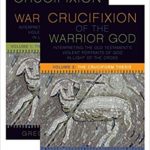We run our website the way we wished the whole internet worked: we provide high quality original content with no ads. We are funded solely by your direct support. Please consider supporting this project.

Christ-Centered or Cross-Centered?
The Christocentric Movement
Thanks largely to the work of Karl Barth, we have over the last half-century witnessed an increasing number of theologians advocating some form of a Christ-centered (or, to use a fancier theological term, a “Christocentric”) theology. Never has this Christocentric clamor a been louder than right now. There are a plethora of published works not only on the need for a Christocentric theology, but also on the need for Christocentric hermeneutics, Christocentric preaching, Christocentric living, Christocentric ethics, and Christocentric ecclesiology. In as much as I believe to the core of my being that everything pertaining to God should be rooted in Christ, I am on one level an enthusiastic fan of this Christocentric movement. At the same time, as one who has read a good deal of what this Christocentric movement has produced, I have to confess that I’m beginning to suspect this term has come to mean precious little. I have put down more than a few allegedly Christocentric tomes and wondered to myself, “What was distinctly Christ-centered about that?”
Part of the problem, I think, is that the Jesus of the Gospels provides too wide a target, so to speak. His teachings and actions can be interpreted a lot of different ways, depending on what you want to emphasize. So, for example, despite Jesus’ unqualified command to love and do good to enemies as as his unqualified prohibition against violence, I have found a number of authors who zero in on his dramatic demonstration in the Temple and his command for disciples to buy swords on the night of his arrest to qualify his anti-violence teachings and to go on to enlist Jesus in support of our government (oddly, never other people’s government) engaging in “preemptive strikes.” The truth is, Jesus can be co-opted to be used to support almost as wide an array of things as can the Bible.
This has particular relevance for the project I’m presently engaged with. For the last four years I’ve been wrestling with the issue of how to interpret the violent portraits of God in the Bible in a way that allows us to see how they are not only consistent with Christ, but actually bear witness to Christ — for with Calvin, Luther and most Protestants since, I believe all Scripture is written to bear witness to Christ (see Jn 5:39-47; Lk 24:27). I’ve been surprised, and a little disheartened, to find that, while there is a virtual army of Bible interpreters and theologians today who insist that we must embrace a Christocentric interpretation of the Old Testament, there are precious few who seem to sense the remarkable incompatibility between (say) the portrait of Yahweh commanding the merciless slaughter of men, women, infants and animals in Deuteronomy, on the one hand, and the Christ who dies for enemies and prays for their forgiveness with his last breath, on the other. What is the point of insisting on a Christocentric perspective if the perspective is so broad that it can accommodate portraits as antithetical as these? In the last year I have had a dozen or so people, including two scholars, cite Jesus’ demonstration in the Temple as proof that he was capable of uttering the “show no mercy” command in Deuteronomy! (By the way, none of the Gospel accounts of Jesus’ Temple demonstration say he harmed humans or animals. He merely cracked the whip to cause a stampede of newly freed animals. [Jn 2:12-17]).
A Smaller Bullseye
I’ve come to believe we need a smaller bullseye to serve as our center. And, fortunately, the New Testament itself provides one. For, while every aspect of Jesus’ life and teaching is consistent with the character of God and consistent with the purpose for which Jesus came, not every aspect of his life and teaching reveals with equal clarity the character of God and the purpose for which Jesus came. Jesus was fully God and fully human as much when he was a two-day-old baby as when he hung on the cross, for example, but we learn a lot more about God’s character and purposes from Jesus’ sacrificial death than we do from his feeding at the breasts of Mary when he was two days old. In fact, when it comes to revealing God’s character and disclosing what he was up to in Christ, I submit that Jesus’ sacrificial death on the cross holds center stage. The Son of God certainly didn’t come into the world only to die, but his death on the cross provides the quintessential expression of the character of God and the purpose for which he came. I thus submit that Jesus’ sacrificial death reflects the theme of everything Jesus was about. While it’s reflected with different degrees of clarity and in a variety of different ways, everything Jesus was about reflected the humble, other-oriented, self-sacrificial love of God that was most perfectly displayed on Calvary.
We can see the thematic centrality of the cross reflected in a number of ways throughout the New Testament. For starters, it is clearly reflected in the fact that the Synoptic Gospels are each structured around the Passion narrative. The flow of the narrative is oriented toward the cross and finds its culmination in the cross. Closely related to this, the centrality of the cross is reflected in the fact that Jesus repeatedly tried to teach his disciples that he came to serve and sacrifice for others and that they must be prepared to do the same if they’re going to follow him (e.g. Mt 10:39 16 ; 20:28).
In John the thematic centrality of the cross is expressed primarily in the role Jesus’ death plays in glorifying the Father. In one crucial passage Jesus acknowledges that his soul is “troubled” and that he wants to cry out, “Father, save me…” He continues, however, by saying: “No, it was for this very reason I came to this hour.” Jesus then prays, “Father, glory your name!” at which point a voice thunders from the sky; “I have gloried it, and will glorify it again.” Jesus then tells his disciples; “Now is the time for judgment on this world; now the prince of this world will be driven out. And I, when I am lifted up from the earth, will draw all people to myself.” And then, just to be perfectly clear, John immediately adds: “He said this to show the kind of death he was going to die” (Jn 12: 27-28, 31-33; cf. 13:31-32). It is evident that, while Jesus glorified the Father throughout his ministry in as much as he always carried out the Father’s will, the Father is “most glorified through the direct manifestation and ‘lifting-up’… of the Son,” as Andrew Moody notes [1]. Not only this, but Jesus’ words in John make it clear that by this same means, and for this same reason, his death in principle ends the reign of “the prince of this world” while drawing “all people” to himself. These were also things Jesus was doing throughout his ministry, but they receive their culminating expression on the cross.
The thematic centrality of the cross is reflected in a wide variety of other ways as well. For example, the cross lies at the heart of every one of Paul’s mini-proclamations of the Gospel, as N.T. Wright and a number of scholars have noted. The cross is also consistently put forth as the central revelation of God’s loving and merciful character as well as the center piece of the example of Christ that his followers are to imitate (e.g. Eph. 5:1-2; 1 Jn 3:16) Moreover, while God’s saving work should not be restricted to the cross, it nevertheless remains true that the cross is spoken of as the means by which humans are reconciled to God, by which our sins are atoned for, by which the devil is defeated and by which the creation is set free. And this thematic centrality is powerfully reflected in the fact that the sign that we are given to remind us of the new covenant — the “Lord’s supper” — is all about the blood that was shed and the body that was broken on the cross.
Applying the Filter
Finally, I submit that even the resurrection should be understood in light of the cross. This event wasn’t just a display of brute power that can be understood apart from, let alone contrasted with, the humble, cruciform character of God that Jesus revealed on the cross as well as throughout his life. It rather is a display of power that confirms that God’s cruciform way of fighting evil is in fact victorious! This is why all who now participate in Christ’s resurrected life (Col 2:12; Eph. 2:6) take on this same cruciform character and are empowered to lay down their lives for enemies, as Jesus did, instead of trying to vanquish them. (This is also the basic theme of the Book of Revelation, I would argue. But that is for a another blog.)
In light of all this, I’d like to propose that we stop using so much Christ-centered (Christocentric) terminology and start using more Cross-centered (cruciformcentric?) terminology. The latter captures everything the first captures, but with a much sharper focus — a focus that can’t be used to support preemptive strikes and that at least feels the weight of the conflict between the crucified God and the portrait of a genocidal God in Deuteronomy. And at the same time, its a focus that allows us to see how violent portraits of God in Scripture are “God-breathed” (2 Tim.3:16) and bear witness to Christ, as I will argue in “The Crucifixion of the Warrior God.”
_____
[1] A. Moody, “That All May Honour the Son: Holding Out for a Deeper Christocentrism,” Themelios 326.3 (2011), 403-14 [414, fn 437]. The original has “through” italicized.
Note: This article was originally published on the temporary blog Greg used prior to the launch of ReKnew.org.
Category: General
Tags: Cruciform Theology, Theology
Related Reading

If the violent depictions of God in the Bible are not completely accurate, isn’t all of Scripture up for debate?
Question: I’m very intrigued by your cruciform hermeneutics and can’t wait for your book (Crucifixion of the Warrior God) to come out. But I have to say that it strikes me as dangerous. You’re basically saying that the violent portraits of God in the OT are not completely accurate. But doesn’t this place us flawed…

Crucifying Transcendence
The classical view of God’s transcendence in theology is in large borrowed from a major strand within Hellenistic philosophy. In sharp contrast to ancient Israelites, whose conception of God was entirely based on their experience of God acting dynamically and in self-revelatory ways in history, the concept of God at work in ancient Greek philosophy…

Rethinking Transcendence
Going back to pre-Socratic philosophers and running through the major strands of the church’s theological tradition, the conception of how God (or, in ancient Greece, “the One”) was arrived at primarily by negating the contingent features of the world that were deemed inferior and in need of explanation. God transcended the world, for example, by…

God Became What He is Not To Reveal What He Is
We are saved because Jesus became the curse of the law for us (Gal. 3:13). So too, the way Christ freed us from the condemnation of sin and enabled us to “become the righteousness of God” was by becoming sin for us (2 Cor. 5:21). What is more, since the curse of the law includes enslavement to…

Why Are Jesus’s Parables So Violent? (podcast)
Greg pops the hood to offer a helpful tutorial on how parables operate. Episode 609 http://traffic.libsyn.com/askgregboyd/Episode_0609.mp3

Reviewing the Reviews: Tom Belt (Part 1)
Tom Belt has written a four-part review of Crucifixion of the Warrior God on his blog An Open Orthodoxy. Parts 1 and 2 offer an overall fair and balanced summary of CWG, at least to the point that correcting misunderstandings would feel petty. In Part 3 Tom offers a critique of volume I, and this is what I’d like…
